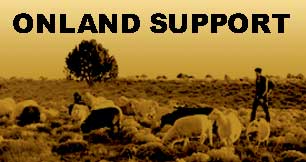The Long Walk
January 12, 1999 by pathfinder
Filed under Uncategorized
During the time before the Long Walk, traditional Navajos tell stories of why the Dine’ suffered the tremendous hardships of the Long Walk.
Traditional Dine’ believe that all problems and suffering are caused by disharmony with the following teachings and natural laws. When one lives in disharmony and disobeys the laws of nature, one brings upon themselves problems and suffering. The sufferings caused by the most painful event in Dine’ history known as the Long Walk, is attributed to such disharmony.
It is said that the Dine’ had two medicine bundles, one representing all that is good in life and is termed (Hozhooji (Blessing Way) and the other Hochxoo’ji (Evil Way) representing the negative side of life. These bundles were placed with the Dine’ by the Diyin Dine’e (Holy People) so they could live in harmony with each other and the universe.
Problems arose with the Dine’ civilization because many of the people began to disrespect the traditional teachings and the need to live in harmony. Those who valued the traditional teachings tried to impress upon the people the need to follow the teachings, but were unsuccessful. As a result, the views and priorities of those that did not fully respect the tradition took precedence and began to take on the leadership of the Dine’. Traditional Dine’ had no choice but to agree to the leadership of the progressive Dine’ who did not respect the teachings. It is told that they agreed to let this new leadership lead the Dine’ for four years.
During the four years, things got worse, especially between the new leadership and those that strongly adhered to the traditional ways. As a result of this situation of disharmony, many of the prayers, songs, ceremonies, and even the healing herbs and medicines became ineffective and disease became eminent. The natural environment seemed to be in a state of confusion. This weakened and caused the disharmonious state of the Dine’, eventually leading to the Long Walk. Many Dine’ were forced to travel hundreds of miles to an area in present day New Mexico known as Hweeldi’ (Bosque Redondo or Fort Sumner), thousands of Dine’ were killed or left to die enroute to this place.
With this in mind, the U.S. Calvary went on a campaign to force the Dine’ to give themselves up. The Dine’ were accused of raiding other tribes, spaniards, and the white people when in reality it was the outside forces intruding on traditional Navajo land. The soldiers came and burned their cornfields, hogans, molested women and children, and slaughtered their livestock. They captured women and young girls and sold them into slavery because of their excellent weaving skills which also brought a higher price.
The Dine’ were taken to Ft. Sumner, by groups. They were not taken all at once. The first group comprising of women and children were taken. Other groups were taken by way of Santa Fe. The reasoning behind this was to show the citizens of Santa Fe that the Dine’, who were bound in chains, had been conquered. Navajos that could not walk any more and women who were giving birth were shot and left behind for scavengers. They were being herded at a fast pace, the Navajo were not given time to rest, and even build a fire. It is said that this all took place within one year, starting with the Fall of 1863 and ending in the winter of 1864. With inclement weather during the winter, some Navajos died from exposure, starvation, and malnutrition. Approximately 10,000 Navajos were taken into captivity.
The reason the Dine’ were taken to Ft. Sumner was to break their connection with the sacred mountains as is evident when one visits Ft. Sumner where no mountains can be seen in all directions. The four years of suffering and captivity would forever be remembered by the Navajos. Barboncito was selected as head leader to represent the Navajos to negotiate a treat with the United States government. At the time the plans for the captives was to send and settle them in Oklahoma, Mississippi, and Florida to assimilate them along with the eastern tribes. He pleaded with the U.S. Calvary for the release of all Navajos, but was unsuccessful. The traditional ceremonies, songs, and prayers kept the hopes of the people alive that they would eventually return home within the sacred mountains and guided them in the treaty negotations. The Dine’ then gathered together and held a traditional coyote ceremony and when they saw the coyote depart from the camp towards the west, they knew they would return home. The treaty was made and then signed by Naat’aanii (head spokespersons). After the signing of the treaty the Dine’ gathered and regretted the suffering, because it should not have happened in the first place because of the people’s failure to respect the traditional values and culture.
Upon their return from Ft. Sumner, the people planted cornfields, but their planting yielded little crops for four years. The traditional religious leaders and Naat’aanii discussed the problems the Dine’ were faced with and agreed that harmony needed to be restored among the Dine’ through an Ndaa’ (Enemy Way) ceremony. Harmony was once again restored upon the DIne’. At this time, it is also told that a Naahid ceremony was also held. This ceremony was held to rejuvenate and restore harmony among the Dine’ and nature. The Naachid ceremony is composed of several ceremonies that begin the Fall and end in the Spring. With the completion of the Naachid, harmony was restored upon mother earth. It is said that a Dine’ woman initiated the Naachid, and therefore the Dine’ women is recognized as having an important role in government. After this the land, crops, livestock, culture and way of life, was once again restored and began to prosper.
This page is a product of The Agency Network Program under the Office of the Speaker.
This article was copied from http://www.navajo.org/lwalk.html , their server is often down so it is reprinted here as it appears on their site.
Updated January 1999
Copyright 1999 Agency Network Program. All rights reserved.
webmaster@dine.navajo.org


